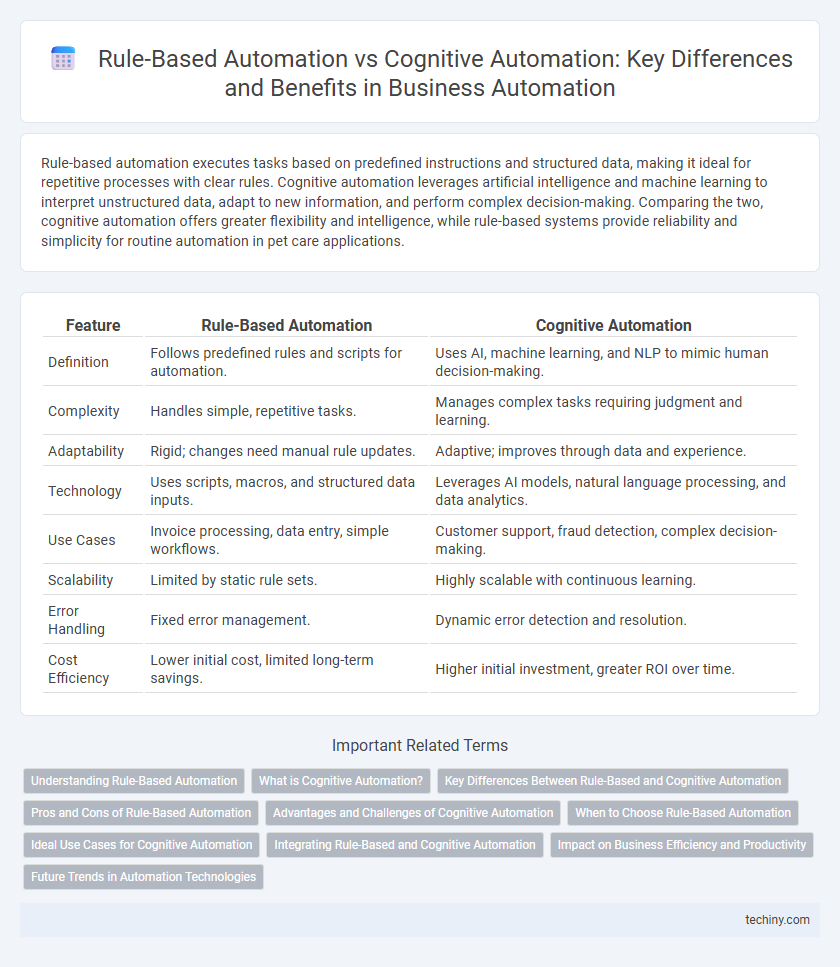Rule-based automation executes tasks based on predefined instructions and structured data, making it ideal for repetitive processes with clear rules. Cognitive automation leverages artificial intelligence and machine learning to interpret unstructured data, adapt to new information, and perform complex decision-making. Comparing the two, cognitive automation offers greater flexibility and intelligence, while rule-based systems provide reliability and simplicity for routine automation in pet care applications.
Table of Comparison
| Feature | Rule-Based Automation | Cognitive Automation |
|---|---|---|
| Definition | Follows predefined rules and scripts for automation. | Uses AI, machine learning, and NLP to mimic human decision-making. |
| Complexity | Handles simple, repetitive tasks. | Manages complex tasks requiring judgment and learning. |
| Adaptability | Rigid; changes need manual rule updates. | Adaptive; improves through data and experience. |
| Technology | Uses scripts, macros, and structured data inputs. | Leverages AI models, natural language processing, and data analytics. |
| Use Cases | Invoice processing, data entry, simple workflows. | Customer support, fraud detection, complex decision-making. |
| Scalability | Limited by static rule sets. | Highly scalable with continuous learning. |
| Error Handling | Fixed error management. | Dynamic error detection and resolution. |
| Cost Efficiency | Lower initial cost, limited long-term savings. | Higher initial investment, greater ROI over time. |
Understanding Rule-Based Automation
Rule-based automation operates on predefined rules and structured data, executing repetitive tasks with high accuracy and consistency in environments with clear logic and predictable outcomes. It excels in automating routine processes such as data entry, invoice processing, and customer query responses by following explicit decision trees and if-then conditions. This form of automation lacks adaptability to unknown scenarios and depends heavily on rule precision, making it ideal for straightforward workflows but limited in handling complex, unstructured data.
What is Cognitive Automation?
Cognitive automation leverages artificial intelligence technologies such as machine learning, natural language processing, and computer vision to mimic human decision-making and adapt to new information without explicit programming. Unlike rule-based automation, which follows predefined instructions, cognitive automation processes unstructured data, understands context, and continuously improves its performance through learning. This enables businesses to automate complex tasks requiring judgment, pattern recognition, and problem-solving at scale.
Key Differences Between Rule-Based and Cognitive Automation
Rule-Based Automation operates on predefined rules and structured data, executing repetitive tasks with high accuracy but limited adaptability. Cognitive Automation leverages artificial intelligence technologies such as machine learning and natural language processing to understand unstructured data, enabling decision-making in complex scenarios. Key differences include the ability of cognitive systems to learn and improve over time, unlike rule-based systems which require manual updates for new conditions.
Pros and Cons of Rule-Based Automation
Rule-based automation excels in executing repetitive, well-defined tasks with high accuracy and speed, enabling businesses to reduce operational costs and minimize human error. Its limitations include inflexibility in handling exceptions or unstructured data, requiring frequent updates to rules as processes change. This approach is best suited for simple workflows but struggles with the scalability and adaptability demands of dynamic environments.
Advantages and Challenges of Cognitive Automation
Cognitive automation leverages artificial intelligence and machine learning to interpret unstructured data, enabling more complex decision-making and adaptive learning than traditional rule-based automation. Its advantages include enhanced accuracy, scalability, and the ability to handle ambiguous or evolving tasks without explicit programming. Challenges involve high implementation costs, integration complexity, and the need for continuous data training to maintain system efficacy.
When to Choose Rule-Based Automation
Rule-based automation excels in environments with predictable, repetitive tasks that follow clear, predefined rules and structured data, making it ideal for processes like invoice processing or data entry. This approach offers cost-effective implementation and faster deployment when business rules are stable and unlikely to change frequently. Rule-based automation suits organizations seeking to improve efficiency without complex decision-making or machine learning capabilities.
Ideal Use Cases for Cognitive Automation
Cognitive automation excels in complex scenarios requiring natural language processing, machine learning, and decision-making in unstructured data environments, such as customer service chatbots, fraud detection, and medical diagnosis support. Unlike rule-based automation, which follows predefined rules for repetitive tasks, cognitive automation adapts and learns from data, making it ideal for dynamic, unpredictable workflows. Industries like finance, healthcare, and retail benefit significantly from cognitive automation by enhancing efficiency and accuracy in critical decision processes.
Integrating Rule-Based and Cognitive Automation
Integrating rule-based automation with cognitive automation enhances process efficiency by combining predictable task execution with AI-driven decision-making capabilities. Rule-based systems handle repetitive, structured workflows, while cognitive automation applies machine learning and natural language processing to interpret unstructured data and adapt to changing conditions. This synergy enables organizations to optimize operational performance, reduce errors, and improve scalability across complex business environments.
Impact on Business Efficiency and Productivity
Rule-based automation streamlines repetitive tasks by following predefined instructions, significantly reducing errors and operational costs while accelerating workflow processes. Cognitive automation leverages artificial intelligence and machine learning to handle complex decision-making and adapt to changing conditions, enhancing business agility and enabling more strategic resource allocation. The integration of cognitive automation drives higher productivity gains and deeper insights, transforming business efficiency beyond the capabilities of rule-based systems.
Future Trends in Automation Technologies
Future trends in automation technologies emphasize a shift from traditional rule-based automation, which follows predefined scripts, to cognitive automation that leverages artificial intelligence and machine learning for adaptive decision-making. Cognitive automation enhances process efficiency by enabling real-time data analysis and predictive insights, driving smarter, more flexible operations. The integration of AI-powered cognitive systems with existing RPA tools is expected to accelerate digital transformation across industries, fostering innovation and reducing operational costs.
Rule-Based Automation vs Cognitive Automation Infographic

 techiny.com
techiny.com